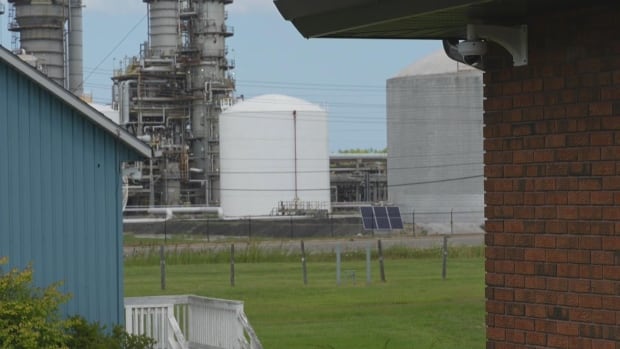For Jason Plain, Aamjiwnaang First Nation is home. On Tuesday, he was deciding whether to leave temporarily, as a neighbouring Sarnia, Ont., company had started work to remove a toxic chemical, leading the First Nation to warn of potentially higher levels of the chemical in the air.
“We’ve got a really good community, but yeah, there’s been some sicknesses and everything like that, every now and then. We don’t know if it’s from the plants. We never really know — it’s just come to light these last few years, now they’ve got [air quality] monitoring,” Plain told CBC News.
Plain was one of around 100 people advised by the First Nation’s band council to evacuate this week, when Ineos Styrolution would remove benzene from a nearby tank.
Ineos Styrolution uses benzene, a byproduct of fuel refining, to manufacture auto parts, medical appliances and electronics.
Research has shown that benzene exposure can cause cancer, the federal government notes.
High levels of the chemical were registered in the air in April, forcing Aamjiwnaang First Nation to declare a state of emergency after people became ill with headaches, nausea and dizziness.
Ineos temporarily closed around the same time. The Ontario government then pulled its environmental compliance approval in May. The company later said it would be shuttering its doors permanently.
Ray Fisher is another Aamjiwnaang resident who was preparing to leave home for a local motel on Tuesday. He says he thinks all the nearby plants should be cleared.
“I know they’re good paying jobs but … whatever they’re making and letting out is not good for anybody,” he said.
Fisher said he didn’t like the prospect of leaving home and moving his pets, especially the day after the National Day for Truth and Reconciliation.
While about 2,500 people belong to Aamjiwnaang First Nation, about 900 live on reserve.
Chief Janelle Nahmabin previously told CBC News the First Nation established 27 micrograms per cubic metre of benzene as its benchmark that would trigger the closure of some of its facilities. She said about 100 people have been asked to evacuate.
On Tuesday, Nahmabin said she had had a conversation with a band councillor about asking people to evacuate their homes the day after Truth and Reconciliation day.
“He’s like, ‘I was really thinking about how far we’ve come with orange shirt day and the truth coming out and the treatment of our children. But here we are facing this right now,'” she said. “I think it’s an ongoing, an intergenerational thing that we’ll have to do to address that.”
More of the work and activity around the tank will begin on Wednesday.

Ineos said the process should be done before Oct. 16, with an increased potential for emissions between Oct. 2 and 6, according to modelling.
“Any elevated emissions are expected to be localized near the site boundary and are not expected to cause adverse effects to the local population,” the company said in a statement.”
The chemical company says destocking is a routine part of operations within the Sarnia industrial complex, and local authorities are well versed in the standard protocols — adding safety is its “top priority.”
“We are dedicated to protecting our employees, contractors and neighbouring communities, prioritizing safety above all else.”
‘Please just stay alert … always stay alert’
Sarnia fire Chief Jeff Weber wants to ensure communities in the area of where the chemicals are being removed are aware of what’s happening.
“Please, just stay alert … always stay alert,” he told CBC News.
“Emergencies typically don’t happen when we plan them, right? Whether it’s weather, industry and chemical industry or transportation events, it requires everybody to remain diligent. Have a plan, just like we talk about at emergency preparedness week.”

Weber said emergency responders are keeping a close eye on air quality in the area.
“We’re constantly monitoring benzene numbers in the area and certainly from an entire network of monitoring stations — not only on the Ineos site, but also surrounding that site and as far north as the the more residential footprint of the city of Sarnia,” said Weber.

He said the community has websites, along with a digital notification system and alerting sirens.
“Certainly this is an operation that industry does on an ongoing basis, emptying and cleaning tanks. And that is a well-known process.”


